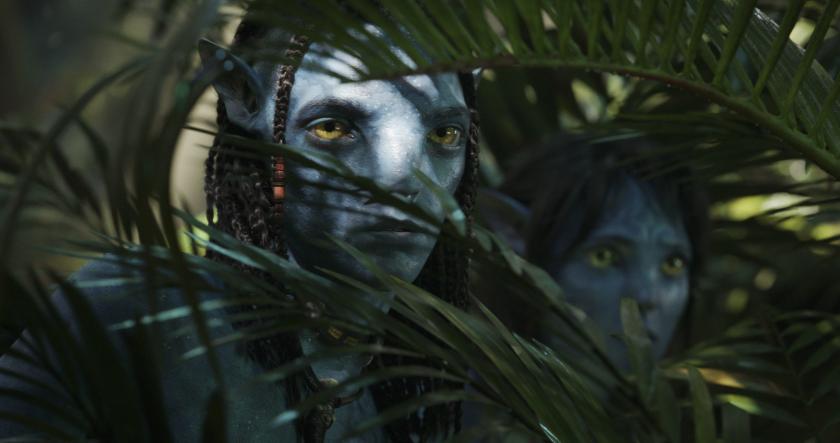You may wonder: is this it? James Cameron’s Avatar sequel replays Earth’s colonial assault on Pandora in the original, cancelling out the blue-skinned native Na’vi’s victory under the Dances With Wolves-like, blue-white saviour command of Jake Sully (Sam Worthington), a paraplegic Marine mentally steering a genetically engineered Na’vi avatar.
Sully has now merged into his avatar, and is chief of the jungle-dwelling Omaticaya, with an equally fearsome wife and five kids (including Sigourney Weaver as her previous character’s avatar’s teenage daughter, pictured below). Earth’s renewed assault to pillage Pandora’s minerals, led by genetically resurrected antagonist Colonel Quaritch (Stephen Lang), becomes absurdly personal as Quaritch hunts the Sullys, who flee to the Metkayina, a Polynesian-style, partially amphibious people, till Quaritch descends here too.
![]() Cameron has spent enormous financial and imaginative capital to make Pandora real; 30 years of his filmmaking life, too, when the last sequel’s done. Yet the result is so often ugly, with computer-game visuals partly designed by a fantasy paperback artist, Wayne Barlowe. The water-world feels more real than the jungle. But there is no visionary pay-off for the vast investment in motion-capture and hybrid 3D, none of the ineffable wonder Cameron sought in his weird box-office misfire The Abyss, or Titanic’s towering ship. A school of whale-like Tulkun wheeling in water and air is the sole poetry. The tribes and animals are avatars of the familiar, not strange new worlds.
Cameron has spent enormous financial and imaginative capital to make Pandora real; 30 years of his filmmaking life, too, when the last sequel’s done. Yet the result is so often ugly, with computer-game visuals partly designed by a fantasy paperback artist, Wayne Barlowe. The water-world feels more real than the jungle. But there is no visionary pay-off for the vast investment in motion-capture and hybrid 3D, none of the ineffable wonder Cameron sought in his weird box-office misfire The Abyss, or Titanic’s towering ship. A school of whale-like Tulkun wheeling in water and air is the sole poetry. The tribes and animals are avatars of the familiar, not strange new worlds.
Two sequences stand out. A Tulkun-hunt, in which one of the giant, pacifist creatures is slaughtered with calculated, cruel efficiency, is intensely emotional, and scored and shot as a martial, seafaring adventure, much like Jaws. Cameron’s action skills are deployed to drag you into an awful act, with a clear whaling analogue. An Okker Aussie hunter (Brendan Cowell) and pursed-lipped, compromised marine biologist (Flight of the Conchords’ Jemaine Clement) add vivid humanity, and the yellow liquid syringed from their victim’s vast brain to halt human ageing is good, sparky science fiction. A final sea battle also becomes the joltingly exciting war film you’d want from Aliens’ director. Multiple replays of Titanic’s near-drownings in a sinking ship and The Abyss’s nautical light fantastic are more wearying auto-homages.
![]() After Black Panther: Wakanda Forever, it’s been a good year for anti-colonial blockbusters, reflecting a sea-change after a century of Hollywood glorifying white might. Cameron clearly equates Quaritch’s Marine tactics with Vietnam and Iraq. “Pacify the natives,” goes the command. “Exterminate the brutes,” in other words (there’s even a visual nod to Martin Sheen’s camouflaged commando surfacing in Apocalypse Now’s hell-red waters). This ideological counterstrike into millions of young cinemagoers’ dreams feels welcome. Sully still uses his Marine skills to machine-gun everyone in sight, and go mano a mano with Quaritch just like John Wayne.
After Black Panther: Wakanda Forever, it’s been a good year for anti-colonial blockbusters, reflecting a sea-change after a century of Hollywood glorifying white might. Cameron clearly equates Quaritch’s Marine tactics with Vietnam and Iraq. “Pacify the natives,” goes the command. “Exterminate the brutes,” in other words (there’s even a visual nod to Martin Sheen’s camouflaged commando surfacing in Apocalypse Now’s hell-red waters). This ideological counterstrike into millions of young cinemagoers’ dreams feels welcome. Sully still uses his Marine skills to machine-gun everyone in sight, and go mano a mano with Quaritch just like John Wayne.
The Avatar films process Cameron’s teen consumption of pulp s.f. – Edgar Rice Burroughs most of all – the way George Lucas transformed Saturday morning serials into Star Wars and Raiders of the Lost Ark, and the MCU does for comics. This is the paperback mulch behind The Terminator, Aliens and The Abyss too. It just seems such thin stuff. There’s not much story, not much script.
![]() Cameron’s vision for Titanic – widely expected to lose its massive financial gamble on release – showed a monomaniac drive to effectively achieve a gruelling cinematic task. In Hollywood terms, he proved the survivor-type he believed he would have been among the real Titanic’s drowning passengers. “I do get pleasure from pulling out of the dive,” he acknowledged to me on its release. “We’re talking about high-stakes poker, we’re talking about making movies.” Having won that bet, he concluded: “I think the people with money know I’ve proved my point now. They’re going to have to let me do anything I want.”
Cameron’s vision for Titanic – widely expected to lose its massive financial gamble on release – showed a monomaniac drive to effectively achieve a gruelling cinematic task. In Hollywood terms, he proved the survivor-type he believed he would have been among the real Titanic’s drowning passengers. “I do get pleasure from pulling out of the dive,” he acknowledged to me on its release. “We’re talking about high-stakes poker, we’re talking about making movies.” Having won that bet, he concluded: “I think the people with money know I’ve proved my point now. They’re going to have to let me do anything I want.”
Avatar doubled down on this relentless drive, sacrificing a decade to its technological achievement, and a decade more to develop its sequels. A more interesting filmmaker has been lost in its jungle. Cameron’s early films mirrored John Carpenter in their sleekly shark-like, ruthless momentum. Now he is Cecil B. DeMille, hawking herculean, hollow spectacles to hold off cinemagoing’s decline.














Add comment